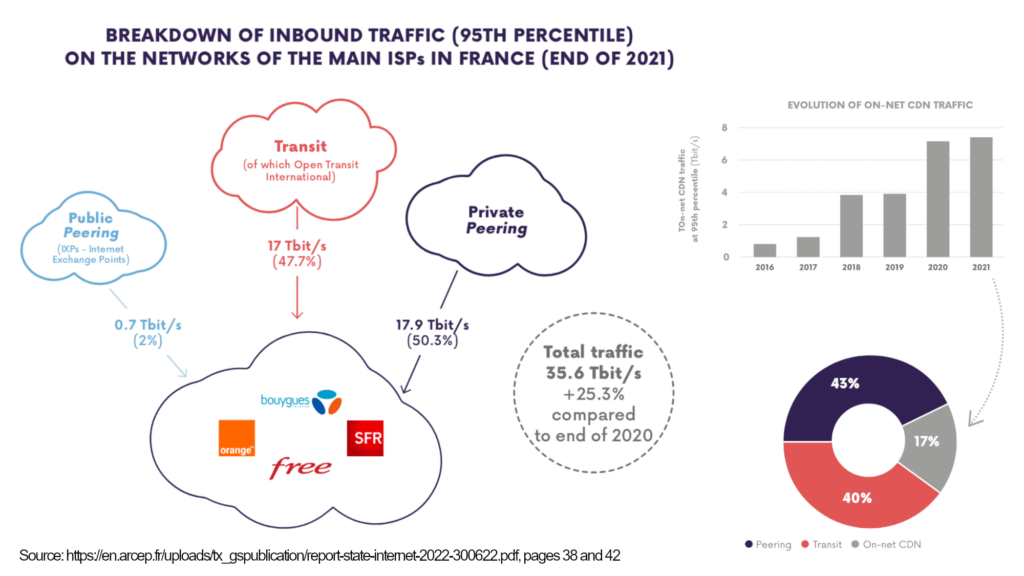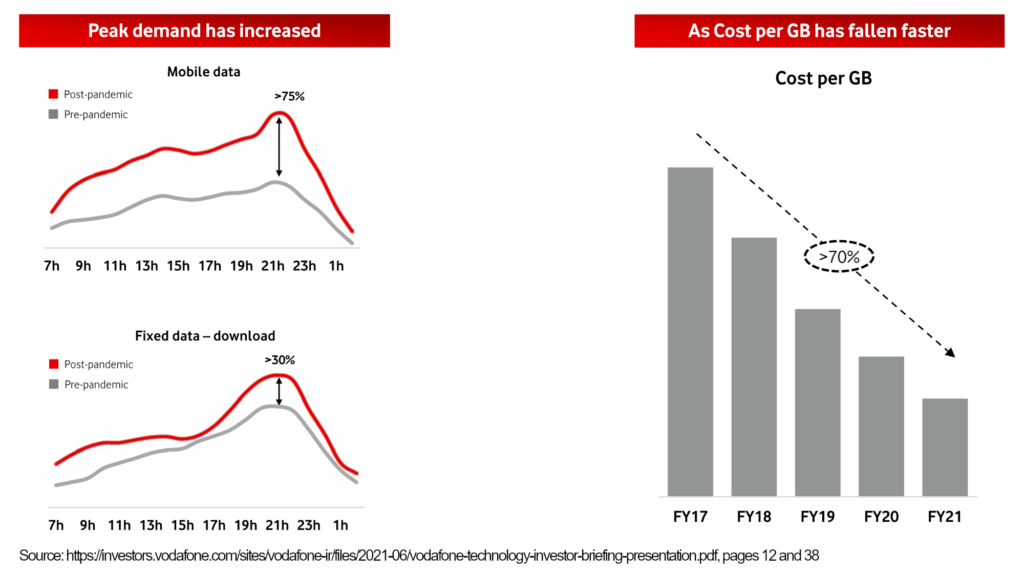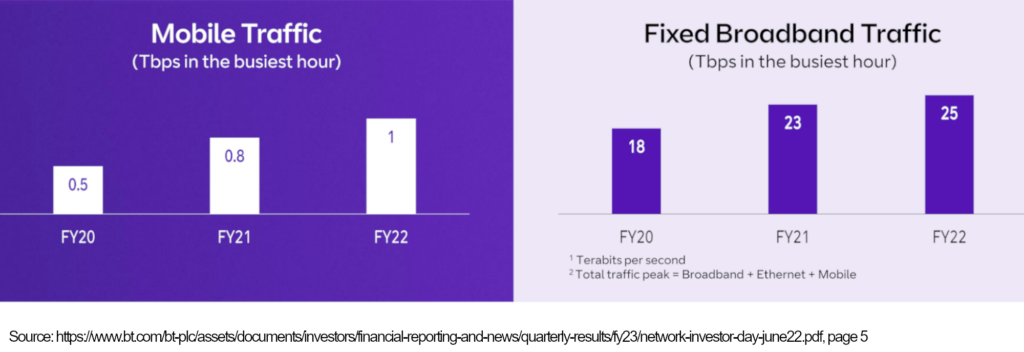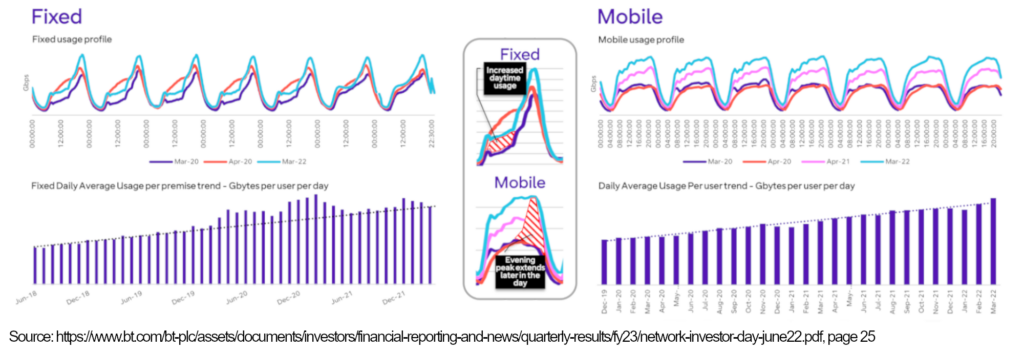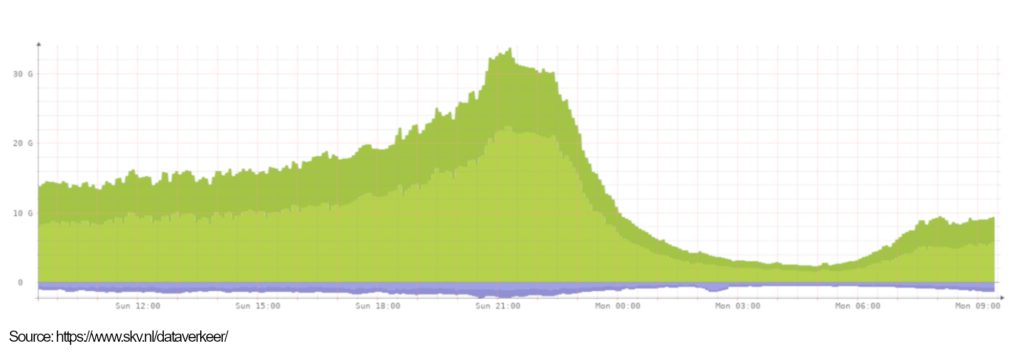Internet Traffic Growth Is Not Out of Control, and Nothing Like Telcos Want You To Believe
Europe’s telecom operators are perpetuating myths about internet traffic growth. On 26 September 2022, CEOs of 16 telecom firms stated “that the largest traffic generators should make a fair contribution to the sizable costs they currently impose on European networks.” They say they fear a scarcity of digital infrastructure to support this traffic. Deutsche Telekom, Orange, Telefónica, and Vodafone did the same in February when they said that internet traffic growth was 50%! Neither defined a time period, nor what unit they measured in.
But while that 50% growth figure is intended to sound high, it doesn’t actually tell us anything about Europe’s internet infrastructure and whether it is equipped to cope. It’s about as useful as saying we need more highways without knowing how many cars are on the roads we already have.
A variety of sources allow us to connect some of the dots. It is important to note that “traffic” can be understood as peak traffic or total traffic. The distinction clearly matters. Total traffic in any network adds up to large numbers, but congestion only occurs when peak traffic exceeds available capacity. A highway can handle many more cars in a whole day than during rush hour.
Deutsche Telekom’s Senior Vice President for Group Public and Regulatory Affairs said in a January 2022 blog post: “YouTube generates the most data traffic on Telekom’s mobile network: In 2021, it averaged 357 terabytes per day, an increase of a remarkable 96 percent over the previous year.” He concluded: “One thing is certain: unchecked increases in traffic volumes caused and monetized by a few large Internet platforms are not sustainable.”
Ominous as it may sound, this is not that significant at all when those big numbers are translated to numbers you and I understand. 357 terabytes per day for YouTube on the T-Mobile network is only 7 megabytes (MB) per customer per day, or less than 30 seconds of video at 2 megabits per second (Mbps). T-Mobile has 53.2 million customers on its German network.

7MB is the equivalent of five of those old 3.5 inch floppy disks you might remember from the nineties! The only way this kind of traffic is unsustainable is if T-Mobile Germany actually turns out to be using floppy disks and Deutsche Post to send that traffic to its customers by post.
Do Orange, Vodafone, Deutsche Telekom, and Telefónica really have a reason to be worried about traffic growth? And what do they tell their investors and others about this? Let’s look at some of the major network providers one by one.
Orange: Existing capacity can absorb increase in use
Telecom firms tell different stories depending on their audience. For example, Orange doesn’t mention traffic anywhere in its financial reporting, which seems strange if it is so important to their CEO.
A blog post published by Orange during the COVID-19 pandemic stated that the lockdown shouldn’t lead to congestion: “In effect, the networks are made to deal with traffic peaks, which usually take place in the evening, in particular when high-audience events are shown (such as major sporting events or certain popular TV series). The existing capacities can therefore absorb the increase in connections that we are seeing at the moment.” Orange’s management praises the new Nokia routers that can handle up to 230 terabit per second (Tbps) per router. The router can “gracefully evolve our networks as we look to manage both planned and unexpected demands in a sustainable way.” So, is 230TBbps per router enough capacity for the traffic Orange’s network has to handle?
Fortunately, there is public data available on traffic growth on the network of Orange. The French regulator Arcep publishes a yearly report on the amount of internet traffic exchanged to and from the four largest French internet service providers (ISPs), including Orange France. In 2021, total peak internet interconnection traffic was 35.6 terabit per second (Tbps), plus an additional 7.5Tbps of on-net traffic by content delivery networks (CDNs), for a total of 43Tbps at the end of 2021.
This means that the total amount of internet traffic exchanged by French ISPs in 2021 saw a 25% increase in peak interconnection traffic year-on-year. In the same report, Arcep says the interconnection capacity of ISPs in 2021 was above 95Tbps, up 40% from 67Tbps in 2020. That 95Tbps is the capacity of the lines connecting these four French ISPs to all other 75,000 networks that make up the Internet. This means that there was 2.7 times more capacity available in France than the interconnection traffic that was actually generated.
Terabits per second may not be easy to understand, so we can translate that amount of traffic into what it means per subscriber. With 30 million broadband subscribers in France, this is just 1.5Mbps of traffic on average per subscriber. French consumers, whose connection speed is often above 1Gbps, shouldn’t worry about the network’s ability to handle 1.5Mbps of traffic, which is just 0.15% of the actual capacity of their connection.
It does appear that with routers that have a capacity of hundreds of Tbps, and actual peak traffic of French telecom firms at around 43Tbps, Orange is correct in saying that its existing capacity can absorb the increase. It also means that there is neither the 50% growth in traffic that its CEO claimed earlier this year, nor that there is a scarcity of digital infrastructure available to carry that traffic – au contraire!
Vodafone: Costs are falling faster than traffic is growing
Vodafone is also telling its investors not to worry: while it does mention 50% traffic growth for fixed and mobile data, it states that this is aggregated data use over the day in exabytes – not peak traffic. However, networks are also built to withstand peak data use. Peak traffic has grown in two years with 30% on fixed and 75% on mobile according to Vodafone. That’s 14% growth per year on fixed and 32% growth on mobile. Vodafone has, however, gone so far as to reassure investors that costs are falling faster than growth in traffic.
Deutsche Telekom saw only 20% growth and Telefónica doesn’t worry either
Deutsche Telekom doesn’t mention its traffic in annual reports, but in an interview with the German consulting firm WIK it confirmed that peak traffic growth in Germany was 20% per annum until the pandemic. This is quite the difference from the 50%, or even 97%, Deutsche Telekom stated elsewhere. COVID didn’t lead to a traffic boost on Deutsche Telekom’s network in part because streaming services voluntarily reduced video bandwidth or increased compression.
WIK says: “The traffic boost that occurred in France due to COVID-19 cannot be observed in the same way in Germany according to Deutsche Telekom’s observations. Although traffic still rose sharply in Q4/2019, it fell again in March 2020 as a result of [initiatives] to reduce the resolution of video services (from HD to SD). The classic seasonal traffic patterns seem to dominate the COVID-19 influence again.”
At the start of the pandemic in 2020, Telefónica saw a 40% peak traffic increase, but it was well equipped to handle this. It congratulated itself on its robust infrastructure, suggesting that far from struggling, telcos are perfectly equipped to deal with current levels of traffic. Telefónica’s Corporate Regulation Manager recently stated that traffic growth in Europe has been 32% over the last decade, or a 16-fold increase. That is not even close to the 50% increase the CEO of Telefónica cited, which would have been a 57-fold increase. In its detailed financial reports, traffic levels or associated costs are not mentioned at all by Telefónica.
So, none of the four telecom firms whose CEO wrote that letter in February, calling on EU lawmakers to introduce network usage fees, appear to have any reason to worry about traffic growth or network capacity.
How do other telcos fare?
It is not only these four big players that have demonstrated they can easily handle traffic growth. BT is one of the few network operators to go into detail about the traffic on its network. In 2022, BT told its investors that its total traffic peak – for broadband, business (ethernet), and mobile – had been 28Tbps, with a 1Tbps peak for mobile and the remaining 27Tbps for broadband and business. This translates to roughly 2.5-3Mbps per BT broadband customer.
The COVID-19 lockdowns weren’t difficult for BT to handle either. On 20 March 2020, BT explained that traffic growth is well within manageable limits and there is plenty of headroom for growth. At that time its peak was 17.5Tbps and daytime peak was 7.5Tbps. Although traffic has increased, the growth of peak traffic has been quite stable. Peak traffic growth was 28% from 2021 to 2022, but only 10% from 2021 to 2022 on fixed broadband. BT has also demonstrated in a graphic how traffic during the lockdowns was distributed differently over the course of the day from before and after. This may mean more gigabytes per user of traffic per day, but not a higher traffic peak to handle.
The bandwidth use per subscriber that BT reports is comparable to other telcos and ISPs. KPN in the Netherlands has published a wholesale offer for FTTH that includes 5Mbps traffic with 21% growth per year. Other ISPs have to pay €1.34/month for this, or a mere 27 cents per Mbps monthly.
SKV Veendam delivers fibre-to-the-home (FTTH) internet to 11,000 customers in a town in the north of the Netherlands. Unlike most ISPs, it publishes its traffic stats in real time. This provides valuable insight into an entire town’s internet use. During a “normal” evening peak traffic is about 26Gbps, or 2.5 Mbps per subscriber. On the evening of the very popular Formula One Mexican Grand Prix, all the extra live streaming amounted to a total traffic peak of – wait for it – 3Mbps per subscriber and 33Gbps in total! Since SKV has two times 40Gbps of redundant capacity, it could suffer an outage of half of its network and still be able to serve all its customers. Similar to what Arcep reports for the four French telcos, SKV has 2.5-3 times more capacity available than it needs to handle extreme peak traffic.
Conclusion
So, in spite of telecom CEOs’ claims, total internet traffic and traffic growth in Europe just isn’t that remarkable at all. Their own firms’ presentations to shareholders and data shared by researchers just prove that. Indeed, if fibre internet has a capacity of a gigabit or more per customer, but we only use a few Mbps on average, telcos have more than enough breathing room and no reason to complain.
For more information about the author

